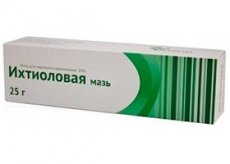Medical expert of the article
New publications
Preparations
Ichthyol ointment
Last reviewed: 03.07.2025

All iLive content is medically reviewed or fact checked to ensure as much factual accuracy as possible.
We have strict sourcing guidelines and only link to reputable media sites, academic research institutions and, whenever possible, medically peer reviewed studies. Note that the numbers in parentheses ([1], [2], etc.) are clickable links to these studies.
If you feel that any of our content is inaccurate, out-of-date, or otherwise questionable, please select it and press Ctrl + Enter.

Antiseptic and disinfectant external agent - ichthyol ointment - is used mainly for skin disinfection. The drug is often irreplaceable in the treatment of urological, gynecological, dermatological problems, as well as other microbial diseases.
Indications Ichthyol ointment
Indications may include:
- dermatological pathologies (eczema, trichophytosis, streptoderma, erysipelas, microsporia, hidradenitis);
- skin damage (burns, superficial injuries);
- inflammation of joints, nerves;
- boils;
- hemorrhoids, anal fissures;
- gynecological problems (salpingo-oophoritis, parametritis, erosion, etc.).
 [ 1 ]
[ 1 ]
Release form
Ichthyol ointment 10% is represented by such ingredients as Vaseline and ichthyol. Ointment 10% is packaged in glass containers of 25 or 30 g.
 [ 2 ]
[ 2 ]
Pharmacodynamics
Ichthyol ointment is characterized by anti-inflammatory and external disinfectant action, as well as antipruritic and keratostatic effects.
The disinfectant effect of the product has a negative impact on the development and vital activity of certain types of pathogenic bacteria - staphylococci, streptococci, and yeast fungi. The product does not affect gram (-) bacteria.
Treatment with ointment helps eliminate itching, improve the quality of the skin, and stimulate skin renewal. Regular use of ichthyol helps get rid of excessive peeling, while simultaneously improving local metabolic processes in the superficial skin layers.
Pharmacokinetics
Ichthyol ointment reveals its anti-inflammatory and analgesic effect already within the first few hours after applying the product to the affected areas of the body.
The ointment does not have a systemic effect due to the negligible penetration of active components into the systemic circulation.
Dosing and administration
Ichthyol ointment is spread over the affected area of skin and rubbed in gradually until a warming sensation appears.
If the ointment is applied as a remedy for eczema, inflammation of the joints or nerves, or a superficial burn, the area with the ointment applied is covered with a piece of gauze and bandaged. This bandage is changed daily until the condition is relieved.
To treat streptoderma, ichthyol ointment is applied using an applicator.
For hemorrhoids and anal fissures, apply the ointment directly to the nodes 1-2 times a day.
For gynecological problems, I often use tampons with ichthyol ointment - this procedure is done exclusively under the supervision of a doctor, so as not to damage the mucous tissues.
The duration of treatment with ichthyol ointment is determined by the doctor, taking into account the characteristics of the disease.
Use Ichthyol ointment during pregnancy
Ichthyol ointment can be prescribed by a doctor for the treatment of pregnant and lactating patients.
When using, care must be taken to ensure that ichthyol does not come into contact with mucous membranes, eyes or nipple area.
Side effects Ichthyol ointment
In most patients, ichthyol ointment does not cause any negative side effects.
Occasionally, the development of allergic processes in the form of skin rashes, itching, swelling, and redness is noted.
If such symptoms are observed, it is better to discontinue the drug and replace it with another, more suitable remedy.
 [ 10 ]
[ 10 ]
Overdose
Since ichthyol ointment does not enter the systemic circulation when applied externally, the risk of overdose is practically zero.
In case of accidental ingestion of the drug, it is recommended to wash out the stomach and take a sorbent drug (for example, activated carbon in the amount of 0.5 g for every 5 kg of the patient's weight).
 [ 13 ]
[ 13 ]
Interactions with other drugs
To avoid unwanted pharmaceutical interactions, it is not recommended to use several topical agents on one area of the skin at the same time.
It is especially undesirable to combine ichthyol ointment with external preparations that contain iodine, ethanol, glycerin, zinc, dimethyl sulfoxide and heavy metal compounds.
Attention!
To simplify the perception of information, this instruction for use of the drug "Ichthyol ointment" translated and presented in a special form on the basis of the official instructions for medical use of the drug. Before use read the annotation that came directly to medicines.
Description provided for informational purposes and is not a guide to self-healing. The need for this drug, the purpose of the treatment regimen, methods and dose of the drug is determined solely by the attending physician. Self-medication is dangerous for your health.

